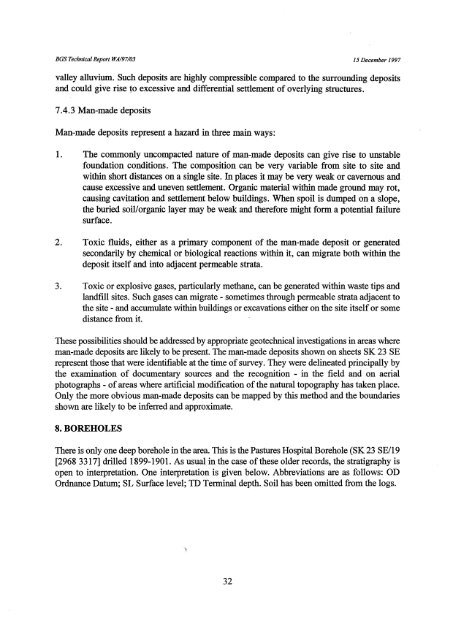Download (3723Kb) - NERC Open Research Archive - Natural ...
Download (3723Kb) - NERC Open Research Archive - Natural ...
Download (3723Kb) - NERC Open Research Archive - Natural ...
You also want an ePaper? Increase the reach of your titles
YUMPU automatically turns print PDFs into web optimized ePapers that Google loves.
BGS Technical Report WM97/03 15 December 1997<br />
valley alluvium. Such deposits are highly compressible compared to the surrounding deposits<br />
and could give rise to excessive and differential settlement of overlying structures.<br />
7.4.3 Man-made deposits<br />
Man-made deposits represent a hazard in three main ways:<br />
1. The commonly uncompacted nature of man-made deposits can give rise to unstable<br />
foundation conditions. The composition can be very variable from site to site and<br />
within short distances on a single site. In places it may be very weak or cavernous and<br />
cause excessive and uneven settlement. Organic material within made ground may rot,<br />
causing cavitation and settlement below buildings. When spoil is dumped on a slope,<br />
the buried soil/organic layer may be weak and therefore might form a potential failure<br />
surface.<br />
2. Toxic fluids, either as a primary component of the man-made deposit or generated<br />
secondarily by chemical or biological reactions within it, can migrate both within the<br />
deposit itself and into adjacent permeable strata.<br />
3. Toxic or explosive gases, particularly methane, can be generated within waste tips and<br />
landfill sites. Such gases can migrate - sometimes through permeable strata adjacent to<br />
the site - and accumulate within buildings or excavations either on the site itself or some<br />
distance from it.<br />
These possibilities should be addressed by appropriate geotechnical investigations in areas where<br />
man-made deposits are likely to be present. The man-made deposits shown on sheets SK 23 SE<br />
represent those that were identifiable at the time of survey. They were delineated principally by<br />
the examination of documentary sources and the recognition - in the field and on aerial<br />
photographs - of areas where artificial modification of the natural topography has taken place.<br />
Only the more obvious man-made deposits can be mapped by this method and the boundaries<br />
shown are likely to be inferred and approximate.<br />
8. BOREHOLES<br />
There is only one deep borehole in the area. This is the Pastures Hospital Borehole (SK 23 SEA9<br />
[2968 33 171 drilled 1899-1901. As usual in the case of these older records, the stratigraphy is<br />
open to interpretation. One interpretation is given below. Abbreviations are as follows: OD<br />
Ordnance Datum; SL Surface level; TD Terminal depth. Soil has been omitted fiom the logs.<br />
32
















